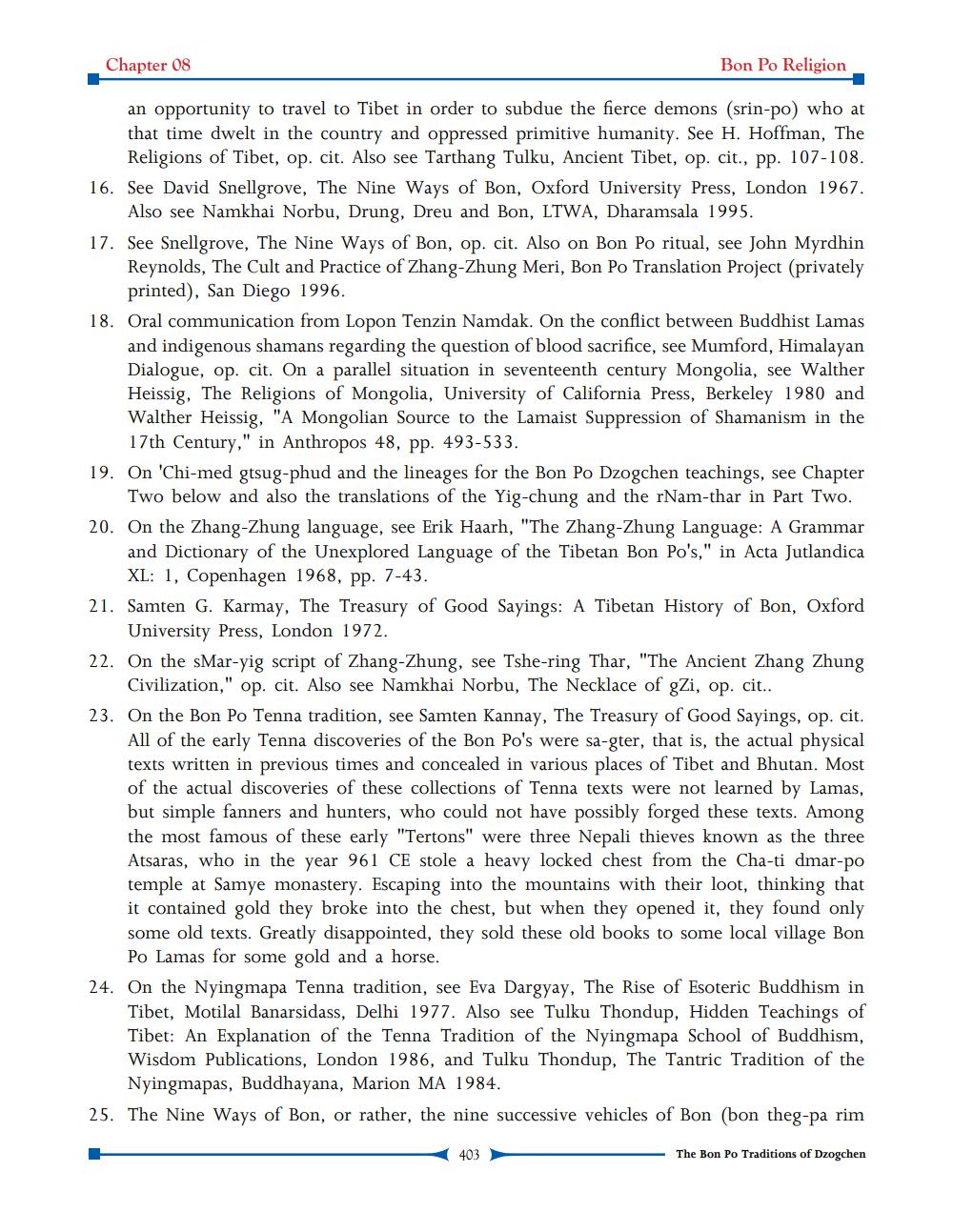________________
Chapter 08
Bon Po Religion
an opportunity to travel to Tibet in order to subdue the fierce demons (srin-po) who at that time dwelt in the country and oppressed primitive humanity. See H. Hoffman, The
Religions of Tibet, op. cit. Also see Tarthang Tulku, Ancient Tibet, op. cit., pp. 107-108. 16. See David Snellgrove, The Nine Ways of Bon, Oxford University Press, London 1967.
Also see Namkhai Norbu, Drung, Dreu and Bon, LTWA, Dharamsala 1995. 17. See Snellgrove, The Nine Ways of Bon, op. cit. Also on Bon Po ritual, see John Myrdhin
Reynolds, The Cult and Practice of Zhang-Zhung Meri, Bon Po Translation Project (privately
printed), San Diego 1996. 18. Oral communication from Lopon Tenzin Namdak. On the conflict between Buddhist Lamas
and indigenous shamans regarding the question of blood sacrifice, see Mumford, Himalayan Dialogue, op. cit. On a parallel situation in seventeenth century Mongolia, see Walther Heissig, The Religions of Mongolia, University of California Press, Berkeley 1980 and Walther Heissig, "A Mongolian Source to the Lamaist Suppression of Shamanism in the
17th Century," in Anthropos 48, pp. 493-533. 19. On 'Chi-med gtsug-phud and the lineages for the Bon Po Dzogchen teachings, see Chapter
Two below and also the translations of the Yig-chung and the rNam-thar in Part Two. 20. On the Zhang Zhung language, see Erik Haarh, "The Zhang Zhung Language: A Grammar
and Dictionary of the Unexplored Language of the Tibetan Bon Po's," in Acta Jutlandica
XL: 1, Copenhagen 1968, pp. 7-43. 21. Samten G. Karmay, The Treasury of Good Sayings: A Tibetan History of Bon, Oxford
University Press, London 1972. 22. On the sMar-yig script of Zhang-Zhung, see Tshe-ring Thar, "The Ancient Zhang Zhung
Civilization," op. cit. Also see Namkhai Norbu, The Necklace of gzi, op. cit.. 23. On the Bon Po Tenna tradition, see Samten Kannay, The Treasury of Good Sayings, op. cit.
All of the early Tenna discoveries of the Bon Po's were sa-gter, that is, the actual physical texts written in previous times and concealed in various places of Tibet and Bhutan. Most of the actual discoveries of these collections of Tenna texts were not learned by Lamas, but simple fanners and hunters, who could not have possibly forged these texts. Among the most famous of these early "Tertons" were three Nepali thieves known as the three Atsaras, who in the year 961 CE stole a heavy locked chest from the Cha-ti dmar-po temple at Samye monastery. Escaping into the mountains with their loot, thinking that it contained gold they broke into the chest, but when they opened it, they found only some old texts. Greatly disappointed, they sold these old books to some local village Bon
Po Lamas for some gold and a horse. 24. On the Nyingmapa Tenna tradition, see Eva Dargyay, The Rise of Esoteric Buddhism in
Tibet, Motilal Banarsidass, Delhi 1977. Also see Tulku Thondup, Hidden Teachings of Tibet: An Explanation of the Tenna Tradition of the Nyingmapa School of Buddhism, Wisdom Publications, London 1986, and Tulku Thondup, The Tantric Tradition of the
Nyingmapas, Buddhayana, Marion MA 1984. 25. The Nine Ways of Bon, or rather, the nine successive vehicles of Bon bon theg-pa rim
(403
The Bon Po Traditions of Dzogchen




